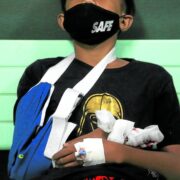The consequences of caring

They were in the hollow ceiling, shifting and shifting against the plywood, squeaking incessantly. Manay Jo and I looked up and then at each other. Ate Li returned inside from sweeping the yard and asked, are those kittens she heard? A pause, leaving nothing but muffled noises. Perhaps—no, maybe they’re just rats.
For three or four days since the first time we noticed, they would make themselves known every hour. At noon, Manay would be cooking, Ate Li would be sweeping, I would give my sickly cat his maintenance meds, and we would listen to the noise. We would ask each other in turn: Those are mice, aren’t they? Maybe they’re kittens? No, they’re just rats. We became less and less sure.
It ate at us. Ate Li and I climbed up the stairs. We pushed the wardrobe away from the wall and unhatched the door to the attic. The shrieks grew closer and clearer as we maneuvered dusty boxes out of the way. Ate Li climbed up and squatted down until she was eye-level with a splintered hole in the wood, while I flashed a light inside it. There, we found three newborn kittens: a sprightly orange one, a tortoiseshell, and a tri-colored runt.
In a perfect world, they would grow up peacefully wherever they were born. But there was my roaming cursed, diseased cat, my cat-hating father nearing his last straw, the mortifying idea of the attic turning into a litter box, and my cowardice. I knew what I had to do.
We laid them outside, in a small box by the old pico mango tree. Awake, they jumped over each other to reach up, squeaking, then tumbled right back down, in cycles. Asleep, they huddled over one another for warmth. Ate Li held onto the hope that the mother—who we figured had snuck through some crevice under the roof and gave birth—would eventually find them at that spot. Manay Jo avoided the area completely, a grave expression weighing down her smile lines whenever she heard their cries from afar. “Ayokong tignan,” she’d say, “Mamamatay lang ang mga ’yan.”
And there was me. From that point, what was I to do? I could go back upstairs, pick up my violin, and continue to practice my études. I could enclose myself in my room’s ivory walls, blocking out any shrieks, worrying only about how my hands, annoyingly small as they were, would traverse the expansive fingerboard while the world spun below me. I paced and fidgeted.
I returned downstairs before nightfall, and the mother was still nowhere to be seen. All three were at the place where we left them, asleep and curled up together. I tiptoed my way back inside the house to prepare a syringe full of water. Then, gingerly, I picked them up one by one. Of course, they woke up.
The kittens were smaller than my hands. I took extra care lifting the tri-colored one—the runt with the weakest movements and the softest shriek. They were resistant, but I thought at least a few drops of hydration would help sustain them. This wouldn’t do in the long run—Google and the online marketplace eventually brought me to the kitten milk replacer which would become their sustenance.
I came back for them every few hours, including the ungodly ones. They slowly grew more and more familiar with the tip of the syringe, accepting it. Then later, the feeding bottle. I brought Manay Jo outside with me and taught her how to feed them while I was out for my classes. Eventually, she agreed to take them home with her.
On the night when she was to leave with them, Manay placed a soft towel in the box. The cries magically ceased. I peeked inside and saw them kneading the cloth cozily. The two of us crossed the Manila smog, through the pavement between my house and the gate—Manay, carrying the box with two hands, and me, handling her overnight bag—with no other noise but the vroom of a passing motorcycle and the polite hum of her Grab ride’s engine.
A few hours later, at around 9 o’clock, she sent me a video on Messenger—the kittens have immediately taken to “feeding” on the breasts of Manay’s sweet white-coated mother cat, now their veritable adoptive mother.
We hired Manay Jo to come over on occasion to help us tend to the house. Otherwise, she would update me on how the kittens have been, saying they have started to cling to the feeding bottle so well, and sending videos of them playing in odd nooks in rapidly growing and fortifying bodies as the weeks and months went by.
I did not think the runt would make it. The one with the sparse white coat spotted black and orange and the weakest meow; the wobbly way she moved looked like she would be blown away by a wisp of wind had she ever managed to escape the box. Her siblings were far more capable of expressing their indignance, pressing their paws against the cardboard wall, yelling up at me, as she timidly remained behind them, unable to push through the tougher ones and make space for herself at the front.
I was wrong. She has become the well-mannered beauty who Manay Jo lovingly calls “Artista.” When they grew old enough, the other kittens were taken in by Manay’s relatives, and she was the only one who remained.
During a recent video call, the pixelated image of Artista, almost a year old and gorgeous, was a few feet beside the stove on the counter, sitting patiently as Manay steamed her fish lunch.
With big innocent eyes, she waited until a bowl was placed right in front of her before she slowly started to dig in. Artista has won over the hearts of Manay’s house guests with her soft meow.
Sami de los Angeles, 23, is a student writer and an interdisciplinary studies major at the Ateneo de Manila University.

















